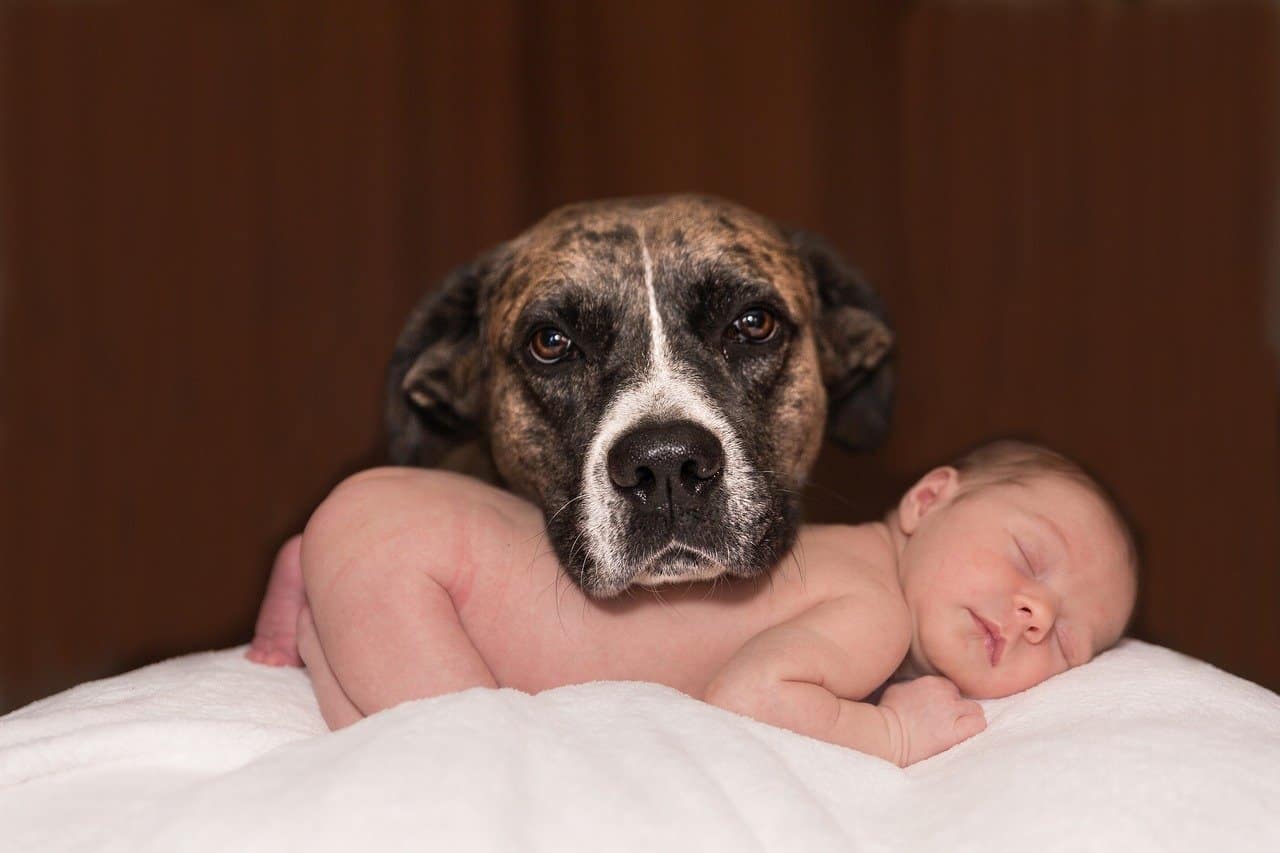If your dog becomes stressed when our baby cries, that is far from abnormal. Dogs are generally confused by or even scared of infants. Here is what you should do in case you have this problem:
- If your dog is growling and threatening the baby, immediately seek the professional help of a dog behaviorist.
- Use systematic desensitization. That means exposing the dog to lower levels of baby noises whenever possible, and then gradually increasing the intensity.
- Attempt counterconditioning. Whenever the child starts crying, present the dog with its favorite treats. That way, the negative association will be replaced with a positive one.
My Dog Becomes Stressed When Our Baby Cries
If our dog becomes stressed when our baby cries, we shouldn’t be surprised.
Dogs have a very peculiar relationship with human babies, and as a result, many expectant parents are not prepared for the problems that might arise when they bring the baby home.
To a dog, a baby doesn’t even appear human — it acts, smells, and looks vastly different.
That is why dogs often stare at babies in confusion, and sometimes, fear.
On top of that, the sounds that babies produce when crying are quite possibly something that our dog has never heard before.
In combination with the high volume and intensity, the crying of a baby can be extremely stressful to a dog that hasn’t been exposed to it before.
So, what do we do if our dog becomes stressed when our baby cries?
The ideal scenario would be to expose it to the particular sounds even before the baby arrives at the house.
However, if it’s too late for that, there are some training and conditioning techniques that will certainly help.
In this article, we will have a close look at all the possible scenarios. But before we jump into it, we need to seriously talk about something else.
A Word of Caution
If our dog exhibits extreme unease or fear when the baby is making noises or has growled at it, we must act immediately.
Such behavior, if left unchecked, might escalate at any time, and we must not risk the safety of our child.
We should isolate the dog from the baby, and seek the help of a dog behaviorist.
If we address the problem early on, there is a good chance that the professional will be able to successfully resolve it.
Another important point we need to make — we should never, under any circumstances, leave the dog alone with an infant.
Even if our pet acts normal and friendly towards the child, circumstances can change in an instant. Additionally, we should always pay attention to when our dog is around the baby.
After all, we are better off safe than sorry.
With that out of the way, let’s explore the different methods we can use if the dog becomes stressed when our baby cries.
Prepare the Dog Before the Baby Arrives
If the baby hasn’t been brought in yet, it is the perfect time to act.
If our dog has been listening to the sounds of a baby crying for some time, it will not be so shocked when it hears them from our baby.
The best way to do that is to use pre-recorded baby sounds. Such recordings can be easily found for free on the Internet — there are even some available on YouTube.
First, we should play the sounds at a lower volume and observe our dog’s reaction. Then, we can gradually increase the volume until it reaches the usual levels.
Our dog might be concerned at first, but with time, it will learn to ignore it.
A great trick is to play the crying baby sounds while our dog enjoys its favorite food. That way, it will learn to associate the noise with a pleasant experience.
If we do this, we should keep the sounds coming from a separate room, for the perfect simulation.
However, if it is too late to employ this tactic, and our dog becomes stressed when our baby cries, we shouldn’t worry.
Let’s explore some training and conditioning methods we can use to resolve the problem and keep our dog happy and peaceful.
Systematic Desensitization
Our dog probably associates the distressing sounds with the baby at this point. So, the dog now views our child as something scary, unpredictable, and possibly dangerous.
This is a hard place to start from, and removing those negative associations can be a bit challenging.
Just like with the audio recordings, we can try and expose our dog to lower levels of baby noises whenever possible.
We must avoid having the dog around for the full-blown, top-of-the-lungs crying, as it might make matters even worse.
Gradually having our dog around when the baby is making low-intensity noises might help the dog realize that there is nothing to be worried about.
The method called systematic desensitization was developed by renowned psychiatrist Joseph Wolpe.
Essentially, it revolves around exposing the dog to triggers that induce low levels of anxiety, and then gradually building up until we reach the extreme.
This method can work wonders if our dog becomes stressed when our baby cries.
A good idea would be to initially keep the dog isolated from the baby. That way, our pet will not be exposed to the “crushing” levels of noise that the baby might make.
Also, our dog will not be able to see the baby, and will not be able to develop a negative association.
Counterconditioning
Another method we can employ is to try and replace the negative associations that our dog has developed to baby sounds with positive ones.
This process is called counterconditioning — basically having our dog unlearn its fear responses. In this case, we need to make sure the dog is happy when our baby starts crying.
The easiest way to achieve that is with proper treats.
For this to work optimally, we will need a partner. When the child starts crying, one person tends to it, while the other provides the dog with some of its favorite treats.
We have to feed them to the dog one by one until the baby has stopped crying.
If we do this consistently, our dog will learn that when the crying session starts, it will enjoy a large number of treats.
That is how you turn a negative association into a positive one.
If we make use of this method, it will be good to start with the dog and the baby in separate rooms.
As our dog is forming a positive association, we can move it closer to the source of the noise. Our goal is to get the dog to actually watch the baby crying.
We can even go a step further in the attempted counterconditioning of our dog.
Animal behaviorist Steve Dale suggests tossing treats in the air as if the baby itself is presenting them to the dog.
This will positively affect the way our dog feels about the child.
With patience and persistence, our dog will actually become happier when the baby starts throwing a fit.
If the Dog Becomes Stressed When Our Baby Cries, There Is a Solution
It is perfectly normal for a dog to become nervous or even scared when it hears an infant crying. If we are expecting a baby soon, it is best to prepare our dog for the inevitable encounter.
However, if we are past that point, the two methods outlined in this article should solve the problem. The best approach is to combine systematic desensitization and counterconditioning.
Of course, we should be careful not to increase our dog’s exposure to the sounds unless it is absolutely ready.
If fear starts manifesting again, we need to go back to square one.
I hope you enjoyed my article on what to do if our dog becomes stressed when our baby cries.
For more informative and interesting articles about dog care, make sure you check out the rest of my blog. See you at the next one!




